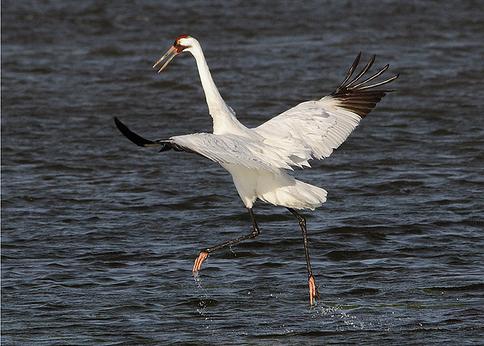
How are they able to live?
 The whooping crane has many adaptations for its marshy, water filled habitat. The piercing yellow eyes are great
adaptations for seeing in the daylight, but the pupil is not
large enough for night vision. Therefore, the whooping
crane is a diurnal organism. The whooping crane has a long,
slender beak that is pointed at the end used for foraging through grass, weeds, etc.
Whooping cranes have great hearing, however, their ears are not
visible as they are covered by feathers. Another significant
adaptation of the whooping crane is found by the beak and ears.
Can you guess what it is? If you guessed the neck, you're
absolutely correct!
The whooping crane has many adaptations for its marshy, water filled habitat. The piercing yellow eyes are great
adaptations for seeing in the daylight, but the pupil is not
large enough for night vision. Therefore, the whooping
crane is a diurnal organism. The whooping crane has a long,
slender beak that is pointed at the end used for foraging through grass, weeds, etc.
Whooping cranes have great hearing, however, their ears are not
visible as they are covered by feathers. Another significant
adaptation of the whooping crane is found by the beak and ears.
Can you guess what it is? If you guessed the neck, you're
absolutely correct!
The neck of the whooping crane is very long so it can get food from the bottom of a lake, stream, or other body of water without getting its body feathers wet. The neck holds the trachea, which is over five feet long, that allows their bulging calls to be heard over five miles away. The whooping cranes neck is very muscular so that it can reach the ground to eat, reach up high to call and dance, and also to reach far behind on their body to preen. Also inside the neck includes the esophagus, vertebrate and spinal cord which are all very important for life.
The body of the whooping crane holds many important adaptations including the wings, heart and lungs, and tail. The gigantic wings of the whooping crane are strong, which is necessary for their long (six to eight week) migrations that can span thousands of miles. The wings are long and broad which allows the cranes to not have to flap as much during flight. Some of you may be wondering why whooping cranes have black on their wing tips. This is because the black feathers contain the pigment melanin which makes them stronger! Since the wing tips get the most wear during flight, it makes sense that the black feathers would be found there. The heart and lungs are adapted to allow the bird to receive enough oxygen during high altitude flights which may reach up to 1800 meters. Whooping cranes usually fly at around 500 meters though, which makes them visible from the ground. The tail of the whooping crane is short so that it doesn't drag them down if they need to take off from the water quickly to avoid a predator.
The whooping crane has extremely long and skinny legs which allows them to stand in water without getting their body feathers wet. The long legs also balance the whooping cranes long neck while in flight. The feet of the whooping crane shows that they do not swim much, even though they do spend a lot of time in the water. How can you tell? Simple. There are not webbings in between the toes like seen in dominant swimming birds, such as ducks. Whooping cranes have a small back toe so their feet do not get caught in the mud. Long back toes are often seen in perching birds, such as the robin, blue jay, or the passenger pigeon which can be seen here. The whooping cranes long, skinny toes allow the bird to support and balance its entire body in squishy situations, such as mud or other soft substrates.
Click here to start learning about the whooping cranes nutrition, or here to visit my homepage.


